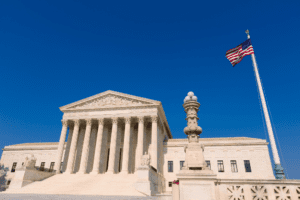 Justice Breyer continued: Indeed, the Court offers many and varied reasons to reject potential representative analogues, but very few reasons to accept them. At best, the numerous justifications that the Court finds for rejecting historical evidence give judges ample tools to pick their friends out of history’s crowd. At worst, they create a one-way ratchet that will disqualify virtually any “representative historical analogue” and make it nearly impossible to sustain common-sense regulations necessary to our Nation’s safety and security.
Justice Breyer continued: Indeed, the Court offers many and varied reasons to reject potential representative analogues, but very few reasons to accept them. At best, the numerous justifications that the Court finds for rejecting historical evidence give judges ample tools to pick their friends out of history’s crowd. At worst, they create a one-way ratchet that will disqualify virtually any “representative historical analogue” and make it nearly impossible to sustain common-sense regulations necessary to our Nation’s safety and security.
Third, even under ideal conditions, historical evidence will often fail to provide clear answers to difficult questions. As an initial matter, many aspects of the history of firearms and their regulation are ambiguous, contradictory, or disputed. Unsurprisingly, the extent to which colonial statutes enacted over 200 years ago were actually enforced, the basis for an acquittal in a 17th-century decision, and the interpretation of English laws from the Middle Ages (to name just a few examples) are often less than clear.
And even historical experts may reach conflicting conclusions based on the same sources. Compare, e.g., P. Charles, The Faces of the Second Amendment Outside the Home: History Versus Ahistorical Standards of Review, 60 Clev. St. L. Rev. 1, 14 (2012), with J. Malcolm, To Keep and Bear Arms: The Origins of an Anglo-American Right 104 (1994). As a result, history, as much as any other interpretive method, leaves ample discretion to “look over the heads of the crowd for one’s friends.” A. Scalia & B. Garner, Reading Law: The Interpretation of Legal Texts 377 (2012).
Fourth, I fear that history will be an especially inadequate tool when it comes to modern cases presenting modern problems. Consider the Court’s apparent preference for founding-era regulation. See ante, at 25–28. Our country confronted profoundly different problems during that time period than it does today. Society at the founding was “predominantly rural.” C. McKirdy, Misreading the Past: The Faulty Historical Basis Behind the Supreme Court’s Decision in District of Columbia v. Heller, 45 Capital U. L. Rev. 107, 151 (2017). In 1790, most of America’s relatively small population of just four million people lived on farms or in small towns. Ibid. Even New York City, the largest American city then, as it is now, had a population of just 33,000 people. Ibid. Small founding-era towns are unlikely to have faced the same degrees and types of risks from gun violence as major metropolitan areas do today, so the types of regulations they adopted are unlikely to address modern needs. Id., at 152 (“For the most part, a population living on farms and in very small towns did not create conditions in which firearms created a significant danger to the public welfare”); see also supra, at 8–9. This problem is all the more acute when it comes to “modern-day circumstances that [the Framers] could not have anticipated.” Heller, 554 U. S., at 721–722 (BREYER, J., dissenting).
The dissent takes an alarmist tone when it claims that the regulations in New York State ae “necessary to our Nation’s safety and security.” 44 other states have provided expansive gun carriage rights consistent with the majority’s decision. The sky is not falling in those 44 states, including some with major cities and high population densities like Florida.
